The first image that comes to mind when you think about getting stronger may well be of barbells and going hard in the squat rack. That’s certainly one way to do it. You can also get absurdly strong with no equipment at all (well, maybe a pull-up bar).
True, you’re going to have to use external resistance like weight plates if you want to build the kind of strength to pull 500 pounds off the ground. But if you’re only working out with your bodyweight, you can get plenty strong, powerful, cardiovascularly fit, and muscular. Bodyweight training develops an elite form of strength that you just can’t develop with a barbell.
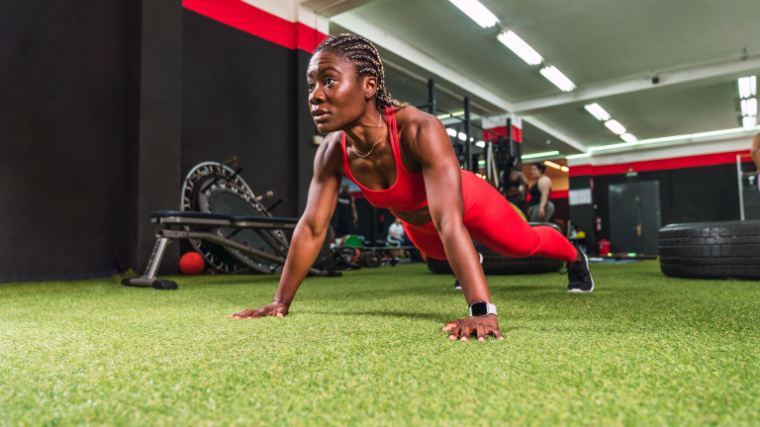
Here, you’ll learn everything you need to know about bodyweight training.
- What Is Bodyweight Training?
- Benefits of Bodyweight Training
- Potential Drawbacks of Bodyweight Training
- How to Start Bodyweight Training
- How to Get Better at Bodyweight Training
What Is Bodyweight Training?
Bodyweight training, also known as calisthenics, is the art of working out with only your body weight as resistance. You won’t be relying on free weights or resistance bands to provide external resistance to increase strength and spur muscle growth. Instead, it’ll just be you and your own body weight providing your training stimulus.
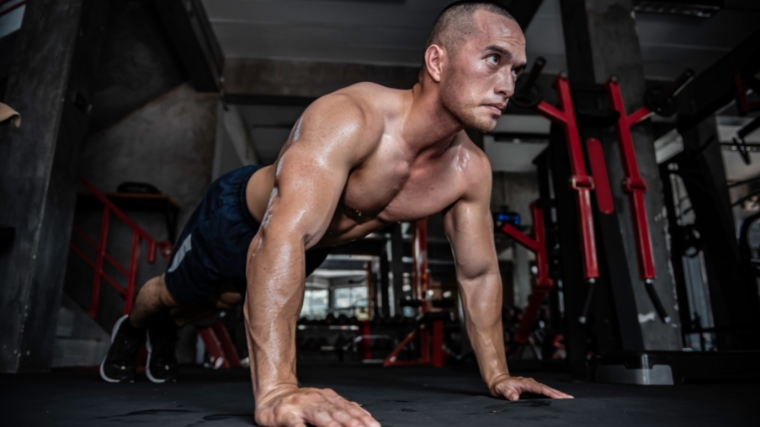
While many people associate calisthenics with advanced gymnastics-style moves like muscle-ups and handstand push-ups, this mode of working out offers a pretty diverse assortment of movements. Bodyweight training includes everything from bodyweight squats, lunges, push-ups, pull-ups, and even box jumps.
But if you can’t do a pull-up or can’t yet achieve a full push-up, bodyweight training isn’t off-limits to you. You can modify bodyweight exercises as needed to suit your needs, skills, body type, and experience levels.
Benefits of Bodyweight Training
Working out with nothing but the weight of your own body is no easy feat. But if you’ve got the patience to master this art, you’re bound to see the benefits seep into your entire physical fitness practice.
Build Strength
You won’t build the same kind of maximal strength with calisthenics that you can with barbells and heavy dumbbells. (1) But you can still get extremely strong on a strict diet of equipment-free training. Especially if you approach failure with your bodyweight exercises, you’ll be able to build a ton of strength. (1)
Cardio Training
Say goodbye to the treadmill — especially if you hate traditional cardio, there might be room in your program for bodyweight cardio. Whether you’re new to training or are simply unaccustomed to activities that will sustain a high heart rate for a prolonged period (looking at you, powerlifters), bodyweight exercises can significantly improve your cardiovascular capacity.
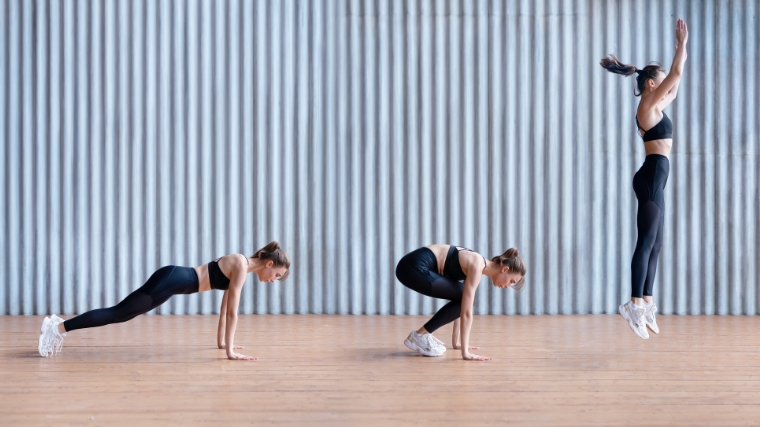
Research shows that performing an 11-minute bodyweight session just three times a week can improve the body’s ability to take in oxygen, otherwise known as the VO2 peak. (2) Not just any bodyweight movements will do, though — you want to opt for explosive moves here for the most effective cardio boost.
In one study, 11-minute sessions packed with high knees, burpees, and split squat jumps performed at a level that each individual found challenging was sufficient to improve cardio fitness. (2) This suggests that you don’t need a lot of time, space, or equipment to improve your cardio capacity.
Maintain or Grow Muscle
You can use bodyweight training to maintain muscle mass or even induce hypertrophy, depending on your strategy and intensity. For example, adding weight or added resistance from bands to your push-ups can produce similar strength increases as equivalently-loaded bench pressing. (3)
As a beginner, you’ll likely be able to grow significant muscle mass with bodyweight exercises alone. But even as an experienced lifter, you can likely maintain muscle without any weights at all, as long as you train close to failure.
Convenience
There are few things more convenient than standing up from your desk, moving two feet away, and banging out a round of push-ups or lunges right then and there. Bodyweight training goes with you wherever your body does — that is to say, everywhere.
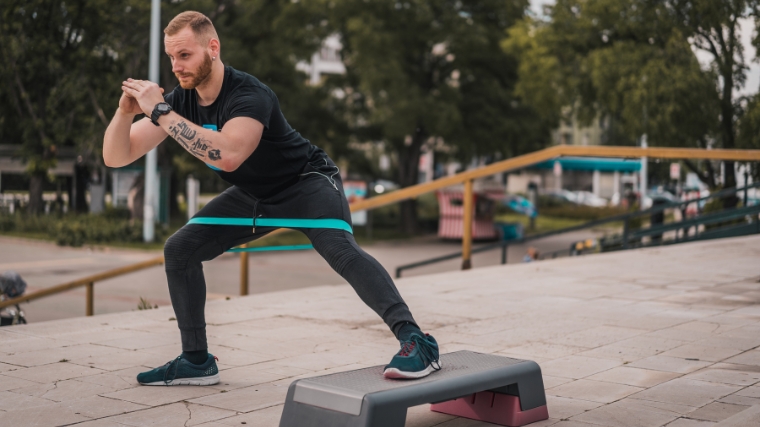
From hotel rooms to your commercial gym, you can do bodyweight workouts anywhere you can get on the ground or jump into the air. Since you don’t need equipment, there’s also no set-up to account for. Especially when you’re looking to up the intensity with shorter rests, bodyweight workouts also tend to be very quick — think 15 to 30 minutes on the long end of things.
Increase Confidence
Benching a few plates or pulling off a heavy snatch is sure to give you a rush of confidence. But even so, there are few feats of fitness quite like nailing your first pull-up or conquering a full push-up or muscle-up after years of trying. Finding your chin over the bar for the first time can be a massive confidence-booster for lifters.
Improve Mobility
Bodyweight movements really require you to move your joints through big ranges of motion. You need tremendous shoulder and thoracic mobility (and stability) to perform pull-ups, while L-sits require flexible hamstrings. Lunges of all variations and split squats all develop hip and ankle mobility.

So it’s not just strength you’ll be building during your bodyweight session. You’ll also be making yourself more mobile, which pays off in spades during your heavy lifting.
Potential Drawbacks of Bodyweight Training
Powerlifters and strongman athletes aren’t going to be judged on their ability to crank out pull-ups. When your personal goal and the goal of your sport is to lift the heaviest weights you can, there’s no way around it — you’ll need more than just your body weight.
Limited External Load
The long and short of it is, if you want to be able to lift heavy weights, you need to lift heavy weights. Just like not everyone who can bench 225 can do a pull-up, not everyone who can do a pull-up can heft multiple plates.
While bodyweight training can be — and is — a tremendous asset to your one-rep max dreams, it’s just not going to get you there by itself. Just like you can’t perfect throwing a football by only throwing a baseball, you’ve got to play your sport to win your sport.
Harder to Overload Posterior Chain
There are tremendous bodyweight back exercises to pepper into your training. Supermans and wall walks are no joke. And bodyweight glute exercises also go harder than you might think. Hamstring slides are also a force to be reckoned with.
But despite the availability of these excellent exercises, your posterior chain hosts some pretty big and powerful muscle groups. To really develop them to the max, you’ll likely need to add a lot more external stimuli than what bodyweight training can offer.
Not Strength Sports-Specific
Strength athletes from any sport can benefit tremendously from bodyweight training. This is perhaps especially true of CrossFitters, who face down very high-volume bodyweight workouts in their WODs (workouts of the day). Kipping pull-ups, muscle-ups, and even deficit handstand push-ups and handstand walks become a must at a certain level of CrossFit experience.
But for the other strength sports, you’ll be using bodyweight training to supplement your weight training — it can’t really be used as a replacement in the long term. It’s great for keeping you strong, muscular, and in shape during some off-season microcycles and/or while you’re traveling.
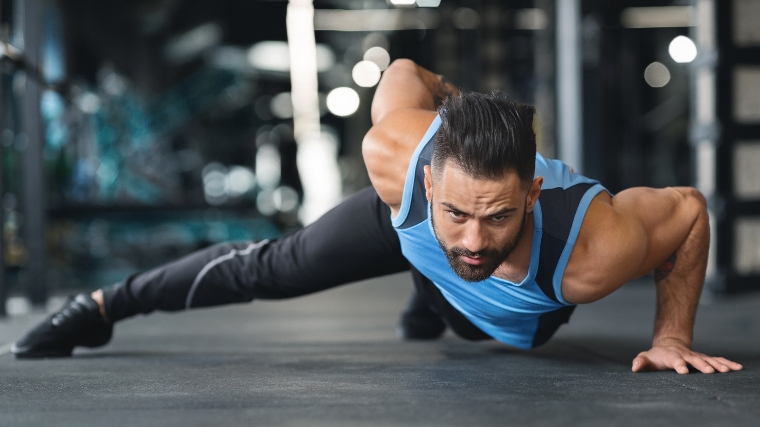
Bodyweight training can’t be your primary go-to as a competitive strength athlete because it just can’t get you the overload you need to succeed at your sport. Using bodyweight moves for mobility and light conditioning can be a tremendous help for bodybuilders and strongman athletes, for example. But you can’t lunge your way to the podium of a strongman competition.
How to Start Bodyweight Training
Some lifters learn how to pull more than twice their body weight off the ground before they can perform their first pull-up. Other athletes start off struggling to perform crunches with solid form and build up from there.
Every athlete starts somewhere. From wherever you’re starting, here’s how to do it.
Assess Your Goals
Different people have a wide array of reasons they might be interested in starting bodyweight workouts. You might be going on the road without reliable access to exercise equipment, or you may be looking to supplement your current strength training routine with a little more volume and skill.
Many athletes also develop a specific goal related to a particular exercise. You might want to master your first muscle-up, finally do a pull-up or pistol squat, hold an extended L-sit or a plank, or sink into a full push-up for the first time. If your goal is related to a specific exercise, a bodyweight-focused routine can help you build up to that move.
Practice Bodyweight Exercises
If you’ve got a level of fitness that allows you to hop up to a pull-up bar and immediately bang out a crisp set of 10 pull-ups, that’s excellent. You’ve still got to practice to take it to that next level. And if you’re starting out performing push-ups on your knees because you can’t do a full version, you have to practice, as well.

Until you can do perfect reps, worry less about performing a specific number of sets and reps and focus on your form. Perform a limited number of reps, gradually increasing your range of motion, until you’re confident enough to move on with each exercise.
Program Your Training
Depending on your goals and abilities, you’ll train a bit differently. If you’re on the road or will be without barbells and weight plates for a while, you may be transitioning to a bodyweight-only training program.
In that case, you’ll need to determine how often you can work out. If you opt to work out more than four or five times a week, you may want to split up your training so that each session focuses on either your upper body, lower body, or core. This will give each muscle group optimal time to recover.
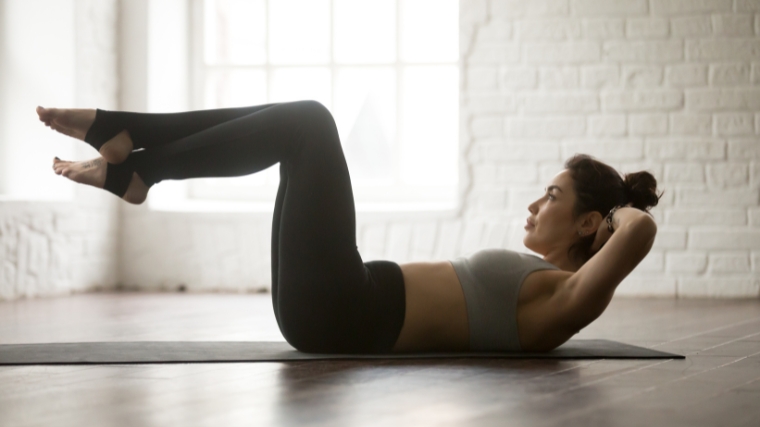
With a lower workout frequency (four times a week or less), you might instead choose to do a full-body split. Here, each workout will involve your entire body.
On the other hand, supplementing your existing program or learning a specific skill means integrating bodyweight moves into your regularly-scheduled strength routine. You might choose to pepper bodyweight exercises into your warm-up, superset them into your workout, or slot extra exercises into your routine.
For example, if you want to get better at pull-ups, start integrating dead hangs, scapular pull-ups, and/or assisted pull-ups into your upper body pull days. If you’re already good at pull-ups but want to be even better — perhaps even build to a muscle-up — add some pull-ups into your warm-up routine, too.
How to Get Better at Bodyweight Training
Whether you’re just starting out or you’ve been doing it for years, it’s easy to feel lost as to how to improve at bodyweight workouts. When you’re working with barbells, you slide on another weight plate when you feel stronger. With other free weights, you grab the next weight up in the dumbbell set.
Progressively overloading your bodyweight training requires you to break out more creative intensity-boosters. You’ll use these techniques in the weight room, too, but they’ll come out to play especially early in your bodyweight workout journey.
Track Your Progress
A big hesitation many lifters have with bodyweight training is that it seems difficult to quantify or track your progress. Sure enough, it’s not as clear-cut as “I can lift this weight for this many reps.” But there are still plenty of ways to keep track of your growth with bodyweight exercises.
Here are some ways you can monitor your bodyweight training progress:
- Perform benchmark workouts once per month. Do a certain number of sets and reps of an exercise or multiple exercises for time. See if you’ve gotten faster and/or the movements feel easier.
- Each month or two, perform a max set of a given bodyweight exercise. Go until you’re a rep or two short of failure. Keep a log of how many reps you reach before approaching failure.
- If you’re performing isometric holds, keep track of how long you can hold an exercise or position each month.
- When your goal is to be able to perform an exercise you haven’t been able to do before (like a muscle-up), keep track of how far along your progress is. (Can you do a kipping pulling? Get over the bar but not press up to lockout?) Log when you finally accomplish that first rep. Then log when you can do two, three, and more.
- This one is less tangible than the others, but keep track of how each exercise feels. Remember when a set of 10 push-ups made your arms shake? How does a set of 10 feel after a month or two of training? Keep track of your RPE — rate of perceived exertion — to monitor how much better you’re getting.
Keeping track of your progress can be a huge part of maintaining your workout motivation. Monitoring how you’re doing with your bodyweight training can definitely help give you reasons to come back for more.
Perform Variations and Modifications
If you want to get better at bodyweight training, you can’t be afraid to give yourself some help. It’s okay to modify exercises to make them more accessible. For example, perform incline push-ups on a weight bench or do them from your knees when you’re building up the strength to do a full push-up.
As long as you’re progressing in your strength and using excellent form, you’ll be on your way to getting better at bodyweight exercises. Use a stronger resistance band to start, and gradually use thinner bands (which give you less help) the stronger you get. Eventually, you’ll graduate to the full version of the moves you’re trying to accomplish.
Incorporate Tempo Training
Take your time moving through equipment-free workouts. Incorporating tempo training — where you’ll take long eccentrics and pauses at different points in your moves — to help pack extra muscle and strength onto your frame.

In addition to building muscle, this method will slow down each rep while speeding up your overall workout. Tempo training will take you to failure more efficiently than mindlessly busting through speedy reps. Because of this, slowing down your reps will speed up your session — a good thing to keep in mind if you’re in a rush.
Use Isometrics
While planks are perhaps the most well-known form of holding an isometric, taking a complete pause mid-rep is another form of tempo training that deserves its own category. Planks and side planks require you to hold your position with your muscles contracted for upwards of 30 and even 90 seconds — but isometrics don’t have to be quite that extreme to be effective.
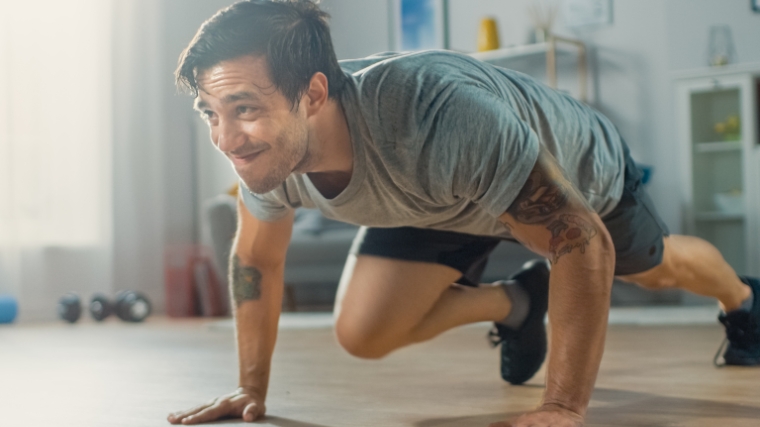
Try performing your regular set of 10 or 20 push-ups at a chipper pace. Then, add a three to five-second pause at the bottom of each rep. It gets a lot harder, a lot faster. You can do the same with pull-ups, except hold at the top of the rep or mid-rep (with your arms at 90 degrees) to create the maximum challenge.
Deploy 1 ½ Reps
Pushing through 1 ½ reps can be torturous. If you’re using this intensity-boosting technique with squats or lunges, you’ll sink down to complete one rep. Come halfway up to standing, then sink back down to the bottom of the lift. Rise to standing again. All of that constitutes one rep.
For a pull-up, you’ll do the same thing but it will look the opposite. You’ll pull all the way up, sink down to where your arms are at 90 degrees, then pull back all the way up. Then you’ll come down, to complete a single rep.

Whichever direction these reps go in, they’ll majorly increase your time under tension. They’ll do so by challenging your form, stability, and mental toughness. Don’t count these out as a way to seriously increase your strength.
Manipulate Rest Times
The less experience you have with bodyweight movements, the more rest you’re likely to need. One simple but challenging way to increase your work capacity and strength is to shorten your rest periods. You can do this with adrenaline-inducing EMOM workouts — that is, performing your reps every minute, on the minute.
Or, you can simply keep diligent track of your rest periods and gradually rest less and less between sets across the weeks. Shave precious seconds off your rest times until you can string more reps together in each set. Keep going from there.
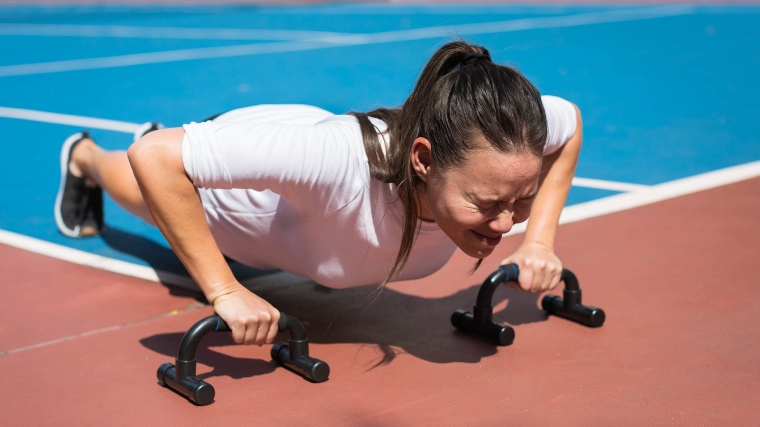
One particularly challenging method of combining high volume with little rest is by performing as many reps as you can, one or two reps short of failure. Say you reach 25 reps. Resting as little as possible in between sets, chip away at replicating that 25 rep number.
Perhaps your next set will have you hitting 15 reps. Rest as little as you can, then max out again. Maybe you’ll get seven reps. Perform your final three reps as soon as possible to total your initial number of 25 reps.
Use Resistance Bands
Resistance bands are often used to provide an external load and make an exercise harder. For example, they’re useful for progressing push-ups when you don’t have weights. But resistance bands are also extremely useful for helping you build the strength you need to perform moves like pull-ups and dips.
Use a thicker band to start with to provide you with as much assistance as you need. Use this assistance to build up your strength, confidence, and technique. Gradually use a thinner (less helpful) band until you can perform your first dip or pull-up.

On the other end of the strength spectrum, you can use resistance bands to increase the challenge of your bodyweight exercises. For example, looping a band around your back can make push-ups more difficult.
Progress With External Loads
You don’t need a full set of dumbbells to add some external load to your bodyweight workouts. Equipment like weighted vests and dip belts (along with some weight plates) can help you increase the intensity of your bodyweight training.
You’ll still be performing bodyweight-focused exercises — pull-ups, dips, and even burpee box jumps — but with the twist of wearing a weighted vest or dip belt. If it’s good enough to challenge elite-level CrossFit Games athletes, external loads will likely be a welcome (and challenging) addition to your own training.
Sample Bodyweight Workout for Beginners
Many people who are new to bodyweight training are looking to get both stronger and more cardiovascularly fit at the same time. This workout will help you approach both of those goals. To start, take as much rest as you need between sets. As you repeat this workout, gradually decrease your rest periods and work toward the higher end of the given rep range.
- Push-Up: 3 x 5-10
- Superman: 3 x 10-15
- Reverse Lunge: 3 x 8-12 per side
- Bench Dip: 3 x 8-10
- Inchworm: 3 x 5
- Bodyweight Squat: 3 x 10-20
Modify movements as needed. For example, perform push-ups on an incline or on your knees if you need to. Similarly, use bands to assist your pull-ups. Make sure that you’re maintaining perfect form, not allowing a kneeling position or use of a band interrupt your midline stability.
Sample Bodyweight Workout for Intermediates
As you gain more experience with equipment-free workouts, you’ll start incorporating higher impact movements. This workout will take the skills you cultivated in the beginner workout and kick it up a notch. You’ll perform this workout as a circuit to get your cardiovascular system revving.
Repeat circuit three to four times.
- Forward OR Walking Lunge: 10 per side
- Close-Grip Push-Up: 10-15
- Pull-Up: 3 reps short of failure
- Box Jump: 5-10
- Beast Crawl: 30 seconds
- Rest two minutes before repeating the circuit.
Once these exercises feel comfortable for you, aim to approach failure toward the end of each set — especially in your later circuits. If you need to deploy methods like 1 ½ reps or tempo training to do so, try it out. On the other hand, if you need to modify any of the movements, do so to ensure excellent form.
Sample Bodyweight Workout for Advanced Athletes
Just because you’re an advanced strength athlete doesn’t mean you are advanced at bodyweight training. If you find that the exercises here don’t quite match your skill set, it’s okay to start out with a beginner or intermediate bodyweight workout.
Repeat circuit four to five times.
- Archer Push-Up: 8 reps per side
- 1 ½ Split Squat: 10-12 reps per side
- Pull-Up: 2 reps short of failure, 3-1-1-0 tempo
- Dip: 2 reps short of failure
- Burpee Box Jump: 10
- Muscle-Up: 3 reps short of failure
- Rest two minutes before repeating the circuit.
Remember that you might be advanced in most movements but still be struggling with others. Be sure to keep customizing your workouts as needed with modifications when necessary. Deploy strategies like tempo training and 1 ½ reps when you need to up the ante.
No Equipment Needed
For many athletes, the truest test of strength is how much weight they can snatch overhead or how many plates they can clean off the ground. But for others, tossing iron around means nothing if they can’t also hoist their own body over a bar.
Whichever extreme you’ve found yourself on — or whatever your starting point is — bodyweight training can likely get you there. Bodyweight training can keep strength athletes well-rounded with solid mobility, and it can teach beginners to hone their body’s power with no equipment in sight. Whatever your goals, there’s no reason to wait. No equipment, no problem.
References
- Suchomel TJ, Nimphius S, Bellon CR, Stone MH. The Importance of Muscular Strength: Training Considerations. Sports Med. 2018 Apr;48(4):765-785.
- Archila LR, Bostad W, Joyner MJ, Gibala MJ. Simple Bodyweight Training Improves Cardiorespiratory Fitness with Minimal Time Commitment: A Contemporary Application of the 5BX Approach. Int J Exerc Sci. 2021 Apr 1;14(3):93-100.
- Calatayud J, Borreani S, Colado JC, Martin F, Tella V, Andersen LL. Bench press and push-up at comparable levels of muscle activity results in similar strength gains. J Strength Cond Res. 2015 Jan;29(1):246-53.
Featured Image: Prostock-studio / Shutterstock